|
This article will to cover Telecom Roaming in more broader manner and how it will be conceptualized in a 5G Network.
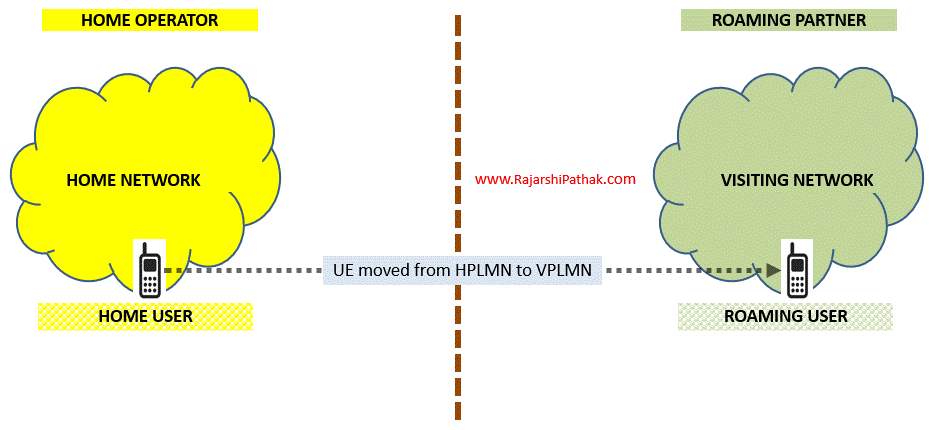
Fig: Roaming Basics
What is Roaming
Roaming is a very critical feature of Telcos which allows the Subscribers to use their Mobile Services outside of the Home Networks. Home Network refers to the Service Provider’s Coverage Area. Services can be making or receiving Calls, Mobile Data usage, Supplementary Services like Call Forwarding, etc.
Roaming provides additional revenue streams for Operators as they can connect Outside Visitors to connect to their Network for the usage as well as allows their Home Subscribers to use the Visitor Network.
Roaming concept is quite old and already 2G/3G/4G subscribers are enjoying this feature worldwide.
How Roaming Works
Roaming agreement and Connectivity (of Signaling and Bearer) between the Operators are required to enable this feature. Connectivity can be direct between the Operators (e.g. between neighboring countries) or it can be via International Hub (e.g. between countries which are geographically far away).
Due to obvious reasons, Operators usually maintain Roaming agreements with more than one Roaming Operators. It allows reliability as well as robustness in the Roaming Connectivity offered to their Home Subscribers.
Concepts of Inbound and Outbound Roamers
Home Subscriber roaming in Visiting Network: This Subscriber will be Inbound Roamer for the Visiting Network and Outbound Roamer for the Home Network.
Visiting Subscriber roaming in Home Network: This Visiting Subscriber will be Inbound Roamer for the Home Network and Outbound Roamer for the Visiting Network.
Through Inbound Roaming, Visiting Network Operator grants access and consumption of its resources to the Roaming Subscribers from the Partner Network.
Outbound Roaming allows Home Subscribers to access the Visiting Network Services as per the Roaming Pack provisioned by the Home Operator.
Usage of common Mobile Services
Home Subscriber activates the Roaming Pack based on the Region/Country of Visit.
Roaming Pack gets activated in the Subscriber’s package.
Home Subscriber moves to the Roaming Country and Switches ON the Phone.
Subscriber chooses either of the 2 Options to register to the Network of Roaming Operator; choose mobile network automatically or choose operator manually from the list.
The Roaming Operator checks the identity of the Subscriber before it latches it on the Network. It verifies whether the Foreign Subscriber has subscribed to Roaming services or not.
Roaming Operator checks with Home Subscriber’s HLR or HSS using Subscriber’s IMSI and downloads the profile in its Visiting Register (E.g. VLR of Roaming Operator).
From the Subscriber’s Subscription Profile, it knows which all Mobile Services are to be allowed in its Network.
The Visiting Network updates Home Operator’s HLS/HSS with the current roaming location of UE.
As the UE is latched on the Roaming Network, Subscriber can start consuming the Voice & Supplementary Services using the resources of Visiting Network.
Additionally, for Data Roaming, GRX (GPRS Roaming Exchange) / IPX (IP Exchange) backbone comes into the picture.
This backbone enables the IP Connectivity between the Roaming Partners and allows IP data routing. Operators also utilize GRX/IPX connectivity for negotiating SLAs as per the required QoS during Roaming operations.
Other infrastructure related to Voice Service Connectivity (of Signaling and Bearer) remains intact for 2G/3G Operators.
4G is a complete IP-based network. So, the UE or Subscribers needs to have the IP Connectivity throughout the time it is latched on the 4G Network. The IP Connectivity can be obtained either from Home Network or Visiting Network.
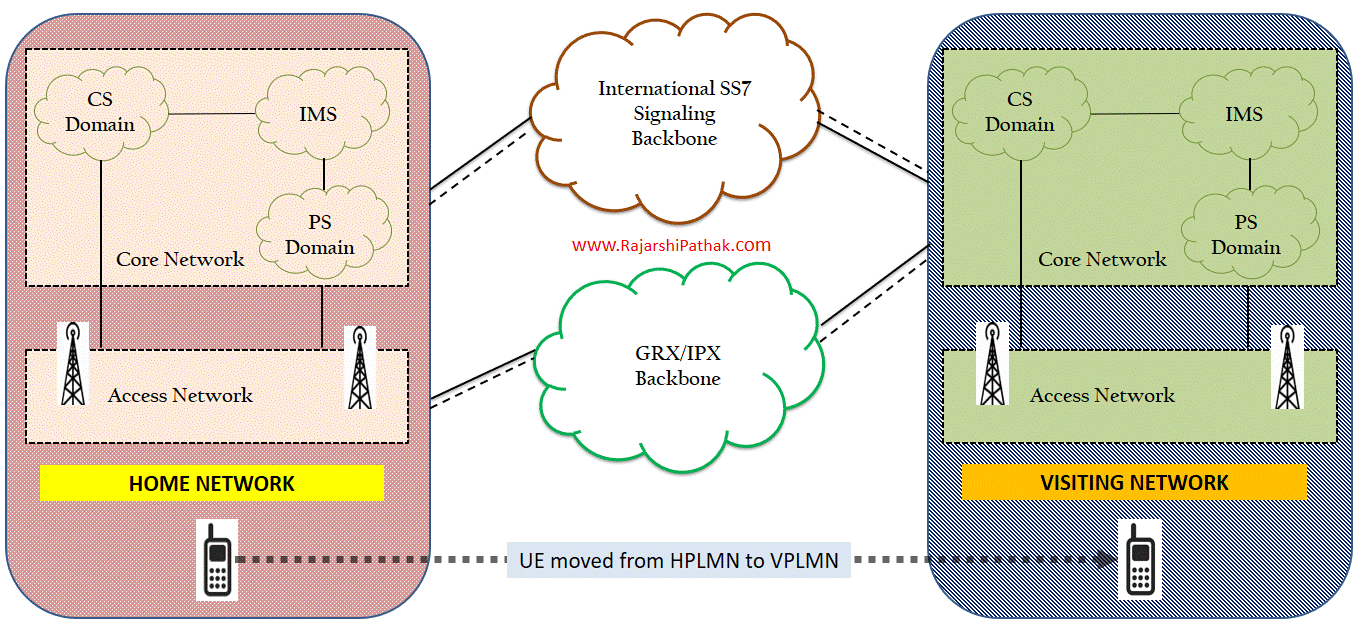
Fig: Roaming Infrastructure
Roaming approaches in a 5G Network
Before going to below section, please refer to the article on Basics of 5G Architecture where I have explained the basics of related 5G Network Functions and Service Based Architecture (SBA).
Local-Breakout: In Local Breakout, data traffic is routed directly from the Visiting Network (VPLMN) to the Data Network while authentication and handling of subscription data is handled in the Home Network (HPLMN). Basic roaming Policy and Charging is applied by the Visiting PCF and CHF as per roaming agreements. In this case only signaling data is routed to Home network.
Here, the IP Address is obtained from the Visiting Network. It means that the UE is using Radio, SGSN (for GPRS/3G) / SGW (for 4G) / AMF/SMF (for 5G) and GGSN (for GPRS/3G) / PGW (for 4G) / UPF (for 5G) of the Roaming Network for the connectivity.
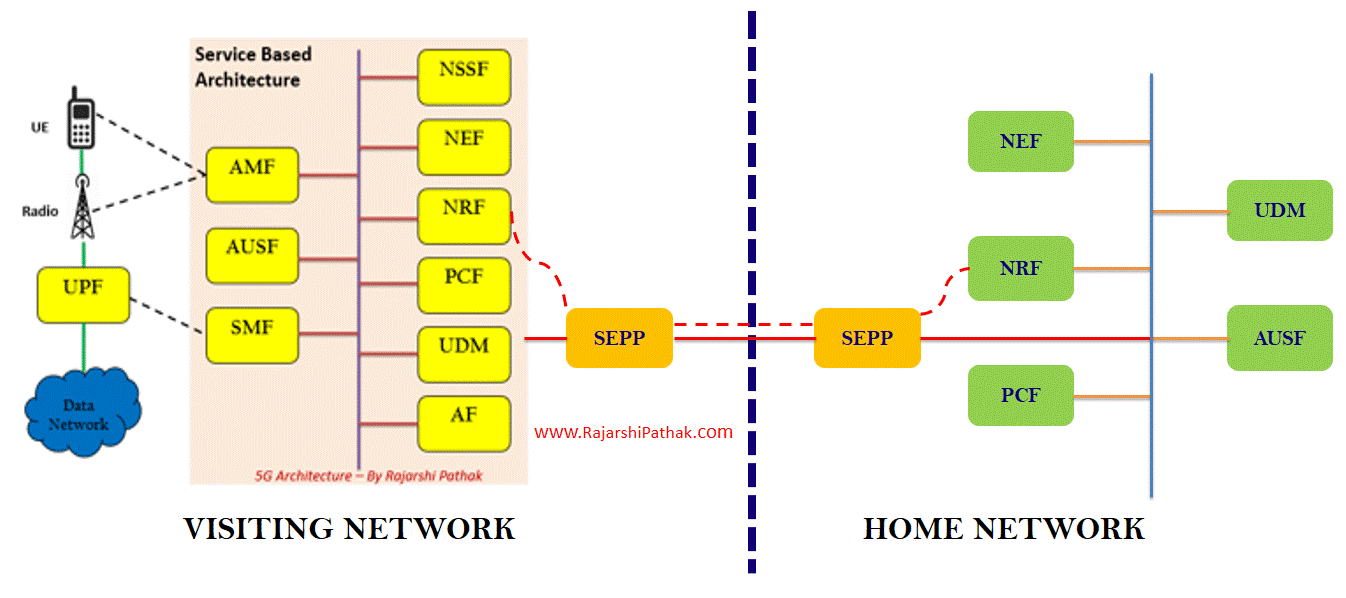
Fig: Roaming – Local Breakout
Home-Routed: In this case, the IP Address is obtained from the Home Network. Here, UE uses Radio & SGSN (for GPRS/3G) / SGW (for 4G) / AMF/SMF (for 5G) of the Roaming Network and GGSN (for GPRS/3G) / PGW (for 4G) / UPF (for 5G) of the Home Network.
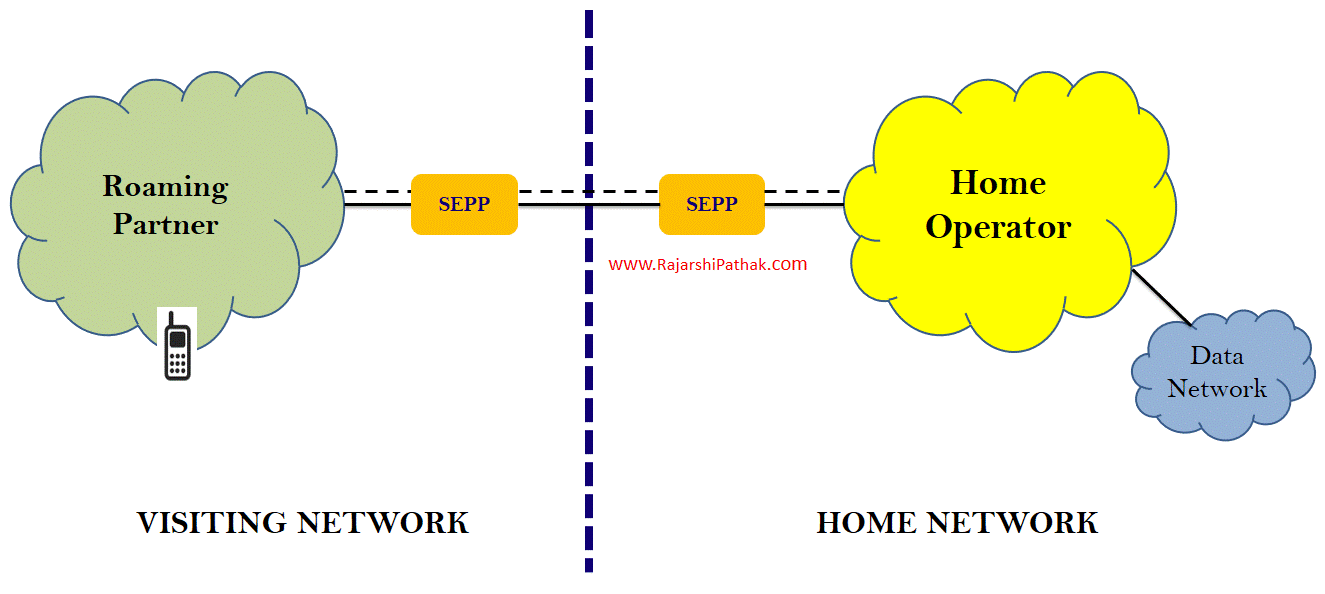
Fig: Roaming - Home Routed
In Home Routed, the Visiting Network data traffic is routed to Data Network via Home network. It provides more control to the Operators wrt offering roaming services, policy and charging the subscribers. However, it adds extra layer of complexity and lag in the network. Along with the signaling data, bearer data is also routed to the Home network.
In 5G Roaming, SEPP (Security Edge Protection Proxy) acts as a service relay between VPLMN and HPLMN for providing secured connection as well as hiding the network topology. You can compare its functionalities as similar to SBC (Session Border Controller) when Voice packets are routed from Core network to IMS network for VoLTE service.
Simplified View of Roaming Usage and Settlements
For the purpose of simplicity, 3rd Party Clearing House is not mentioned.
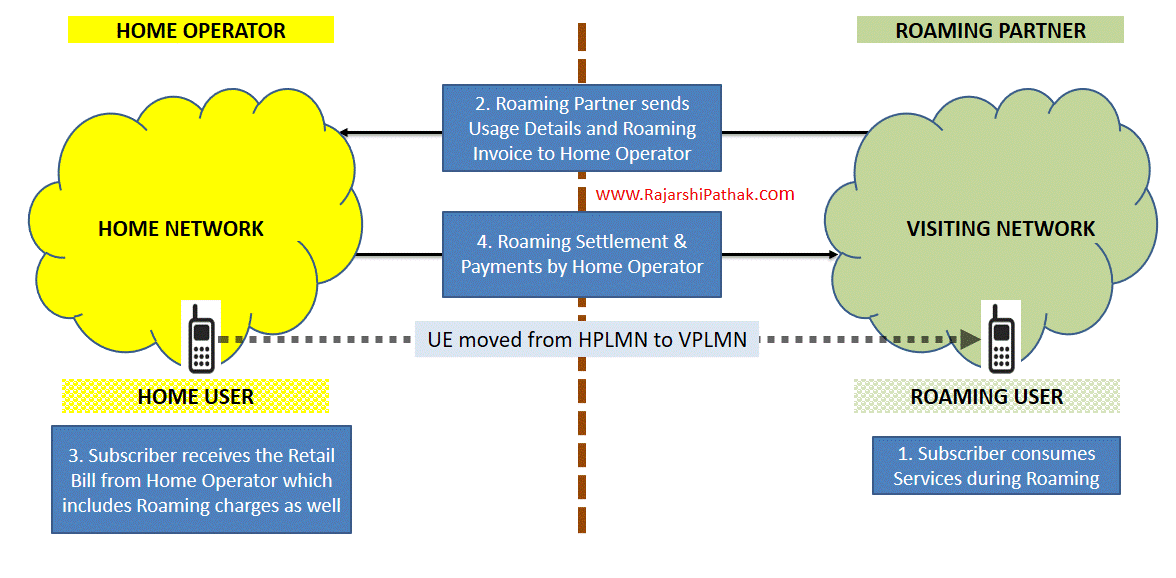
Fig: Roaming - Usage, Billing, and Settlements
Roaming Settlements happen at the Operator’s level by exchanging roaming records for Inbound and Outbound Roamers. In general, these records are mediated via Clearing/Settlement House in the format agreed for the information exchange (E.g. TAP records) between the Roaming Partners.
Home Operator charges the Subscriber for Roaming via its Retail Billing. Operators sell the Roaming packs to their Subscribers to enable the Charging & Usage. Depending on the Regions or Countries, Usage Charges (e.g. Incoming Calls, Outgoing Calls, Data Usage, etc.) varies and you can find the Roaming Charges in the Telecom Operators websites.
Conclusion
It goes without saying that there was quite a no. of advancements made in this field for easing the use and reducing the costs. Roaming has also advanced to remove dependencies on factors like Vendor providers, Devices, Mobile Generation used, etc. between Home & Visiting Networks. Operators are upgrading their traditional OSS/BSS systems to prevent Bill Shocks, perform realtime charging of Roaming records, etc. and also trying to ease the Roaming Operations & Settlements with the technologies like eSIM, Multi IMSI SIM and Blockchain.
I do hope that this article has helped you in some way to understand Roaming and its approaches in the 5G world.
Kindly share this article with your friends and colleagues. Feel free to like and comment. Happy learning.
Glossary: PLMN (Public Landline Mobile Network), HPLMN (Home PLMN), VPLMN (Visiting PLMN), SEPP (Security Edge Protection Proxy), VoLTE (Voice over LTE), EPC (Evolved Packet Core), SBC (Session Border Controller), PCF (Policy Control Function), CHF (Charging Function), IMS (IP Multimedia Subsystem), SBA (Service Based Architecture), UE (User Equipment), UPF (User Plane Function), AMF (Access & Mobility Management Function), SMF (Session Management Function), NEF (Network Exposure Function), AF (Application Function), UDM (Unified Data Management), NWDAF (Network Data Analytics Function), NFs (Network Functions), GRX (GPRS Roaming Exchange), IPX (IP Exchange), IMSI (International Mobile Subscriber Identity), HLR (Home Location Register), VLR (Visitor Location Register), HSS (Home Subscriber Server), SGSN (Serving GPRS Support Node), GGSN (Gateway GPRS Support Node), PGW (PDN Gateway), SGW (Serving Gateway), AUSF (Authentication Service Function), TAP (Transferred Account Procedure), OSS (Operations Support System), BSS (Business Support System)
|
Above article is originally published on my website. Do visit & subscribe for more insightful articles on Telecom Networks & OSS/BSS.
Thank you for your Articles!
Thanks for your kind words.
Very insightful 5G roaming article!
Thank you for sharing,
CeliTech Team.
hi i need roaming service flows
4G, 2G/3G flows needed
Great job. Thank for the very clear and concise description.
Do you have more information you could share about "Roaming Operations & Settlements with ... Blockchain" ?
You can check my comment here - https://www.linkedin.com/feed/update/urn:li:activity:6881602897679937536/
thanks dear for sharing. I am just wondering, how can we use the local breakout during disasters?